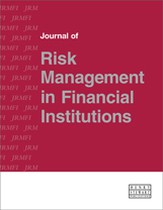A risk-adjusted pricing model for bank loans: Challenging issues from Basel II
Abstract
This paper detects how the Basel II internal ratings based (IRB) approach affects the bank loan pricing mechanism. A multi-period risk-adjusted pricing methodology under the prevalent loan repayment schemes based on the theoretical framework provided by Hasan and Zazzara (2006) is developed. In addition to the previous literature, more light is shed on the contribution of the two types of losses (expected and unexpected) to the total risk-adjusted spread, finding evidence which is consistent with what credit risk modelling theory suggests. On the implications stemming from the adoption of the IRB advanced approach, it is shown that lower risk-adjusted spreads are assured when the effect of longer maturities (higher spreads) is off-balanced by a reduction in loss given default (LGD).
The full article is available to subscribers to the journal.
Author's Biography
Domenico Curcio is an assistant professor at the University of Naples and an adjunct professor at the University LUISS Guido Carli of Rome, where he holds the Chairs of Banks and Financial Markets and Risk Management. Domenico has a PhD in finance from the University LUISS Guido Carli. He is the scientific advisor and teaching coordinator of the area banks and financial intermediaries at the LUISS Business School. Domenico was visiting scholar at the Department of Finance of the Stern School of Business, New York University and at the International Center for Financial Research of the Lally School of Management and Technology, Rensselaer Polytechnic Institute, New York. He has also served as Senior Financial Economist at ASSONEBB (Italian Association of Banking and Finance).
Igor Gianfrancesco serves in the Credit Department at the Banca Popolare di Spoleto, where he works on credit risk management and rating systems. Igor has a PhD in finance from the University LUISS Guido Carli in Rome. He was visiting scholar at the Department of Finance of the Stern School of Business, New York University and at the International Center for Financial Research of the Lally School of Management and Technology, Rensselaer Polytechnic Institute, New York. Igor teaches in the executive training programmes concerning banks and financial intermediaries at the LUISS Business School and he is also an instructor of undergraduate courses at LUISS University. Igor worked in the Research Department at the Capitalia Banking Group, and has also served as Senior Financial Economist at ASSONEBB (Italian Association of Banking and Finance).
Citation
Curcio, Domenico and Gianfrancesco, Igor (2011, March 1). A risk-adjusted pricing model for bank loans: Challenging issues from Basel II. In the Journal of Risk Management in Financial Institutions, Volume 4, Issue 2. https://doi.org/10.69554/WASR5104.Publications LLP
